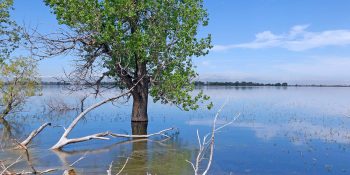LITTLETON, Colo. — All tests for blue-green algae at the dog off leash area at Chatfield State Park have come back negative.
Water samples taken from the ponds at the dog off leash area were tested by the Colorado Department of Public Health and Environmental (CDPHE) Labs, specifically looking for toxins related to blue green algae (microcystin, cylindrospermopsin, anatoxin-a and nodularian). None of those were present in the samples taken from the dog off leash area.
Tests were administered after a report of a dog that died following a visit to the dog off leash area. The veterinarian had told the dog owner the cause of death in that dog was similar to symptoms associated with blue-green algae.
Following that report, inspections of the ponds took place, initial water samples were tested and came back negative before further lab work was sent in to the CDPHE Labs. Those results were confirmed by the CDPHE as negative on the evening of Friday, Aug. 16.
“We will continue to monitor the water quality throughout the park and if anything changes, alerts will be made to inform the public,” Chatfield State Park Manager Scott Roush said.
Be Algae Aware, arm yourself with knowledge and know the options on how you can help be apart of the solution. Below is a Q&A with general information on blue-green algae.
What should a person watch for?
People and their pets should avoid ingesting or swimming in water with heavy accumulations of algae.
Are some lakes more susceptible to algae than others?
Most algae is harmless and an important part of the aquatic food chain. Lakes with high nutrients are more susceptible to blue-green algae, which is the specific type of algae that is capable of producing toxins.
What conditions cause high algae levels?
High nutrient levels (nitrogen and phosphorus in particular) are the biggest factor. Warm temperatures, and calm conditions also contribute.
What can you do?
Don’t feed the algae: Nitrogen and phosphorus in excess grow scummy algae in a lake. The public can help with water quality of our lakes, reservoirs and streams by using phosphorus free fertilizers and picking up after their dog.
How do they test for it?
Colorado Parks and Wildlife goes through several steps when an algae bloom occurs. We identify the species to determine if is a blue-green algae, and if that species is capable of producing toxins. If it is potentially toxic, we use strip tests that can tell if toxins are present. The strips take about one hour to run. If the strip is positive, we work with WQCD and CDPHE for further lab testing.
Is there a safe level for algae?
Most algae is safe and cannot produce toxins. It is an integral part of the aquatic food chain.
Who is in charge of the inspections?
Each lake owner is responsible for their own lake. CPW monitors blooms in our State Parks and State Wildlife Areas, and in partnership with the Water Quality Control Division in CDPHE. WQCD monitors lakes statewide, not just CPW lakes.
What prompts an inspection, is it routine?
CPW does routine visual monitoring for blooms. If we see a suspicious bloom, we identify the algae. If the algae is capable of producing toxins we do further testing in partnership with WQCD and CDPHE.
Does it take a death to prompt an inspection?
No, the presence of an algae bloom at a CPW lake prompts further investigation.
SPREAD THE NEWS
COMMENT, Like, Follow & SHARE @I70Scout
CURRENT EDITION
WEATHER & TRAFFIC PUZZLES RECENT NEWS ADVERTISE WITH US

Leave a Reply